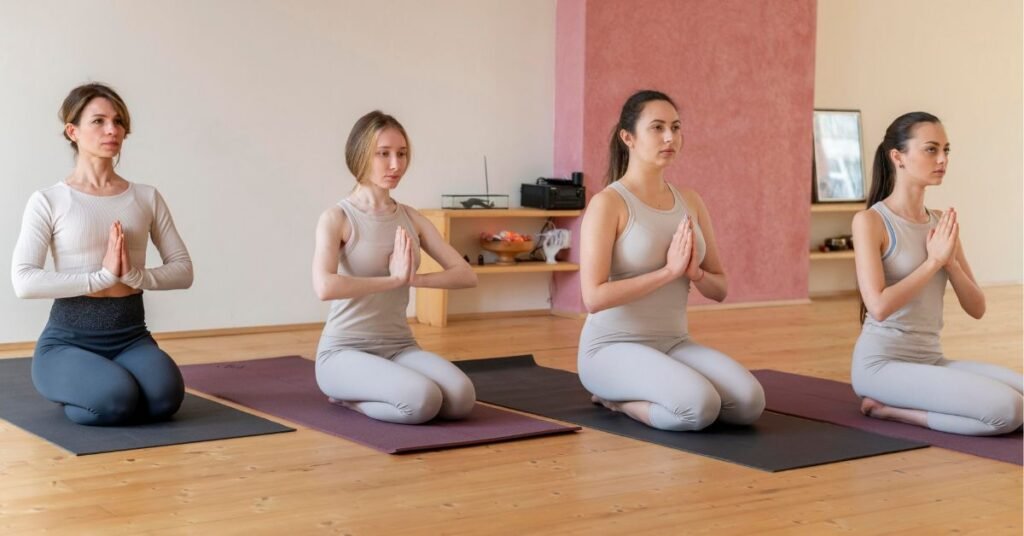Are you ready to embark on a journey of self-discovery, mental clarity, and physical well-being? Kundalini Yoga might just be the transformative practice you’ve been looking for. Often called the “Yoga of Awareness,” Kundalini Yoga combines breathwork, meditation, physical postures, and chanting to awaken your inner energy and connect you to a higher consciousness.
In this beginner’s guide, we’ll explore the fundamentals of Kundalini Yoga, its benefits, and practical tips to help you get started. By the end of this post, you’ll have all the tools and inspiration needed to take your first steps into the world of Kundalini meditations and practices.
What is Kundalini Yoga?
Kundalini Yoga is a unique form of yoga that focuses on activating and channeling the Kundalini energy—a dormant spiritual energy believed to reside at the base of the spine. This ancient practice blends physical movement, breath control (pranayama), chanting (mantras), and meditation to unlock this energy and bring about balance in the mind, body, and spirit.
Unlike other forms of yoga that primarily emphasize physical postures, Kundalini Yoga takes a holistic approach, aiming to:
- Expand your awareness.
- Strengthen your nervous system.
- Connect you with your true self.
The word “Kundalini” comes from the Sanskrit word kundal, which means “coiled.” Imagine a coiled serpent lying at the base of your spine, waiting to be awakened. That’s your Kundalini energy!
The Origins of Kundalini Yoga
Kundalini Yoga has its roots in ancient India, where it was practiced for thousands of years as a sacred and secretive tradition. In 1969, Yogi Bhajan introduced this powerful practice to the West, making it accessible to anyone seeking physical, mental, and spiritual transformation.
Yogi Bhajan’s teachings emphasize that Kundalini Yoga isn’t just about physical fitness; it’s a comprehensive science designed to help individuals thrive in all aspects of life.
What Makes Kundalini Yoga Unique?
If you’ve tried other types of yoga like Hatha or Vinyasa, you might wonder what sets Kundalini Yoga apart. Here are some key differences:
1. Focus on Energy Awakening
The primary goal of Kundalini Yoga is to awaken and raise the Kundalini energy through the seven chakras (energy centers) of the body.
2. Mantras and Chanting
Kundalini classes often include chanting mantras like “Sat Nam” (which means “truth is my identity”) to align your mind and soul.
3. Dynamic Movements
Instead of holding poses for long periods, Kundalini Yoga uses repetitive, rhythmic movements to generate energy and heat.
4. Breathwork (Pranayama)
Breath control is a cornerstone of Kundalini Yoga. Techniques like “Breath of Fire” help to detoxify the body and elevate your energy.
5. Meditation Practices
Every class includes a meditation segment, often combined with chanting or specific mudras (hand gestures), to focus your mind and calm your thoughts.
Readmore: The Best Foods for a Yogic Diet
Readmore: 5 Amazing Reasons to Try Hot Yoga
The Benefits of Kundalini Yoga
Why should you consider adding Kundalini Yoga to your life? Here are some science-backed and anecdotal benefits:
1. Reduces Stress and Anxiety
Kundalini meditations and breathwork activate the parasympathetic nervous system, helping you shift out of “fight or flight” mode and into a state of relaxation.
2. Boosts Energy Levels
Do you feel like you’re running on empty? Kundalini Yoga’s dynamic movements and breathing exercises stimulate energy flow, leaving you feeling revitalized.
3. Enhances Mental Clarity
Regular practice can improve focus, creativity, and problem-solving skills by balancing the brain’s hemispheres.
4. Strengthens the Nervous System
Kundalini Yoga helps build resilience to stress by strengthening your nervous system. You’ll feel more grounded and less reactive to life’s challenges.
5. Improves Emotional Health
Chanting and meditation help release stored emotional blockages, leading to a sense of inner peace and joy.
6. Spiritual Growth
For those on a spiritual journey, Kundalini Yoga provides tools to deepen your connection to your higher self and the universe.
Kundalini Yoga Terms to Know
Here’s a quick glossary to help you feel less like a fish out of water during your first class:
- Kriya: A sequence of exercises, breathwork, and meditations designed to achieve a specific outcome.
- Pranayama: Controlled breathing techniques.
- Mantra: A word or phrase repeated during meditation to focus the mind.
- Mudra: Hand gestures used to direct energy flow.
- Chakra: Energy centers in the body.
- Sat Nam: A common mantra meaning “truth is my identity.”
Readmore: Unlock the Benefits of Advanced Yoga Poses
Readmore: Winter Wellness: 12 Yoga Poses to Stay Warm
How to Prepare for Your First Kundalini Yoga Class
Starting something new can be intimidating, but Kundalini Yoga welcomes practitioners of all levels. Here’s how to prepare:
1. What to Wear
Wear comfortable, loose-fitting clothes made of natural fabrics. Many people prefer wearing white, as it is believed to enhance your aura, but it’s not mandatory.
2. Bring Essentials
You’ll need a yoga mat, water bottle, and possibly a light blanket for relaxation. Some people also bring a head covering, like a scarf or turban, to help contain energy.
3. Keep an Open Mind
You might find some aspects of Kundalini Yoga—like chanting or breathwork—a bit unusual at first. Embrace the experience with curiosity.
Simple Kundalini Meditations to Try at Home
Can’t make it to a class yet? No problem! Here are two beginner-friendly meditations you can do at home:
1. Morning Energizer: Breath of Fire
What it does: Boosts energy and detoxifies the body.
How to do it:
- Sit in a comfortable position with your spine straight.
- Close your eyes and focus on the space between your eyebrows (third eye).
- Inhale and exhale rapidly through your nose, pumping your navel with each breath. Start slow and gradually increase the pace.
- Continue for 1-3 minutes.
2. Calming Mantra Meditation
What it does: Reduces anxiety and promotes inner peace.
How to do it:
- Sit comfortably and take a few deep breaths.
- Chant “Sat Nam” (truth is my identity) out loud or silently in your mind.
- Inhale deeply while thinking “Sat” and exhale while thinking “Nam.”
- Repeat for 3-11 minutes.
Frequently Asked Questions About Kundalini Yoga
Q1. Is Kundalini Yoga Safe for Beginners?
Yes! Kundalini Yoga is suitable for all levels. However, listen to your body and take breaks if needed.
Q2. How Often Should I Practice?
Start with 1-2 sessions per week and gradually increase as you feel more comfortable.
Q3. Do I Need to Be Spiritual to Practice?
Not at all. While Kundalini Yoga has a spiritual component, you can approach it purely for its physical and mental benefits.
Q4. Can I Practice Kundalini Yoga at Home?
Absolutely! Many online resources and videos can guide you through beginner-friendly Kriyas and meditations.
Readmore: Fallen Angel Yoga Pose
Readmore: 15 Best Heart-Opening Yoga Poses
Final Thoughts: Why Kundalini Yoga is Worth Trying
Kundalini Yoga offers a unique blend of physical, mental, and spiritual benefits that can transform your life. Whether you’re looking to reduce stress, increase energy, or explore deeper aspects of yourself, this practice has something to offer everyone.
Remember, you don’t need to master every pose or chant perfectly. Kundalini Yoga is about the journey, not the destination. So grab your mat, take a deep breath, and let the magic of Kundalini meditations guide you to a more balanced and vibrant life.
Sat Nam!

Sonu is a passionate yoga teacher with over 6+ years of experience helping individuals find balance, strength, and inner peace through the transformative power of yoga. As the creator of Pure Yoga Vibes, Sonu shares expert insights, inspiring practices, and a wealth of knowledge to support your wellness journey. Dedicated to creating a space for growth and mindfulness, Sonu’s mission is to make yoga accessible and enjoyable for everyone. For inquiries or collaborations, feel free to reach out at contact@pureyogavibes.com.



